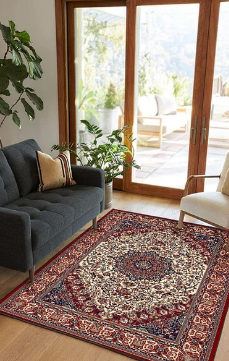Persian rugs are not just ordinary floor coverings; they are true masterpieces of handcraft that embody centuries-old traditions and craftsmanship. The intricate artistry and meticulous techniques involved in creating Persian rugs make them a treasure worth exploring. In this article, we delve into the traditional craftsmanship behind Persian rugs, unveiling the secrets of their creation and the cultural significance they hold.
A Legacy of Handcraft: The creation of Persian rugs is rooted in a rich legacy of handcraft passed down through generations. Persian rug weaving is an art form that requires immense skill, patience, and attention to detail. From the selection of high-quality materials to the weaving and knotting process, every step is carried out by skilled artisans who have honed their craft over years of practice.
Materials of Distinction: Persian rugs are crafted using the finest materials, ensuring both their beauty and durability. Wool, silk, and cotton are commonly used, with each material bringing its unique characteristics to the final product. The wool provides warmth and resilience, while silk adds a lustrous sheen and enhances the intricacy of the design. The choice of materials is a crucial aspect of creating Persian rugs that can withstand the test of time.
Hand-Weaving Techniques: One of the hallmarks of Persian rugs is the use of hand-weaving techniques, which distinguish them from machine-made counterparts. Each rug is meticulously crafted on a loom, with the weaver meticulously knotting individual threads to form the intricate patterns. This labor-intensive process requires exceptional skill and precision, as well as a deep understanding of the design and color scheme.

Intricate Designs and Symbolism: The designs found in Persian Rugs are steeped in symbolism and cultural significance. From floral motifs to geometric patterns, each design tells a story and represents a distinct region or tribe. These intricate patterns are meticulously woven by skilled artisans, often relying on memory and traditional patterns passed down through generations. The designs not only add visual appeal but also carry a deeper cultural meaning.
Natural Dyes and Colors: Traditional Persian rugs are renowned for their vibrant and rich colors, achieved through the use of natural dyes. Natural sources such as plants, flowers, insects, and minerals are employed to create a diverse color palette. These natural dyes not only produce stunning shades but also age gracefully, developing a beautiful patina over time. The use of natural dyes is a testament to the artisans' commitment to traditional methods and the preservation of the craft.
Preserving a Heritage: The creation of Persian rugs is not just an art form but a way of preserving cultural heritage. Persian rug weaving has been recognized by UNESCO as an Intangible Cultural Heritage of Humanity, highlighting its significance and need for preservation. Efforts are being made to support and promote the craft, ensuring that future generations can continue to appreciate the beauty and craftsmanship of Persian rugs.
Appreciating Persian Rugs: Owning a Persian rug is like possessing a piece of history and art. These rugs not only enhance the aesthetics of a space but also carry with them a sense of cultural heritage and craftsmanship. They serve as a testament to the dedication and talent of the artisans who have devoted their lives to mastering the craft of Persian rug weaving. Appreciating Persian rugs goes beyond their visual appeal; it is an acknowledgment of the centuries-old traditions and the stories woven into each intricate pattern.
Conclusion: Persian rugs are true handcraft masterpieces, reflecting the rich heritage and skilled craftsmanship of Iran. From the selection of materials to the intricate weaving techniques and symbolic designs, every aspect of creating Persian rugs is a testament to the dedication and artistry of the artisans involved.